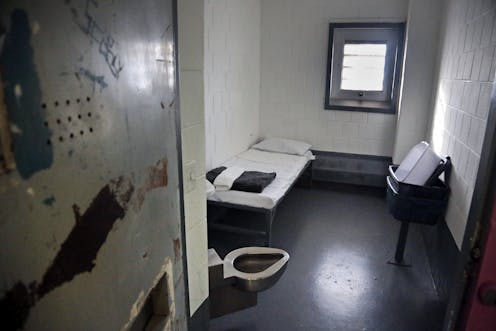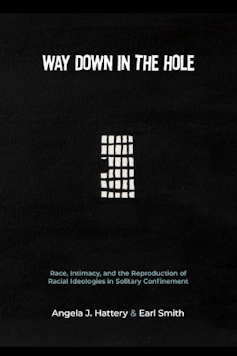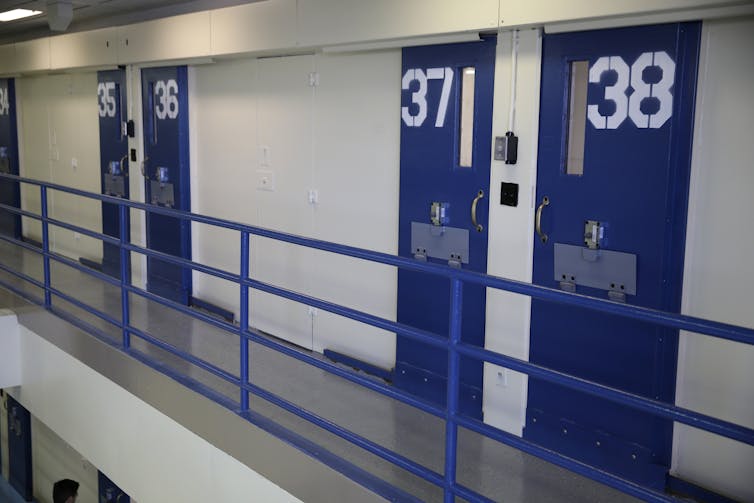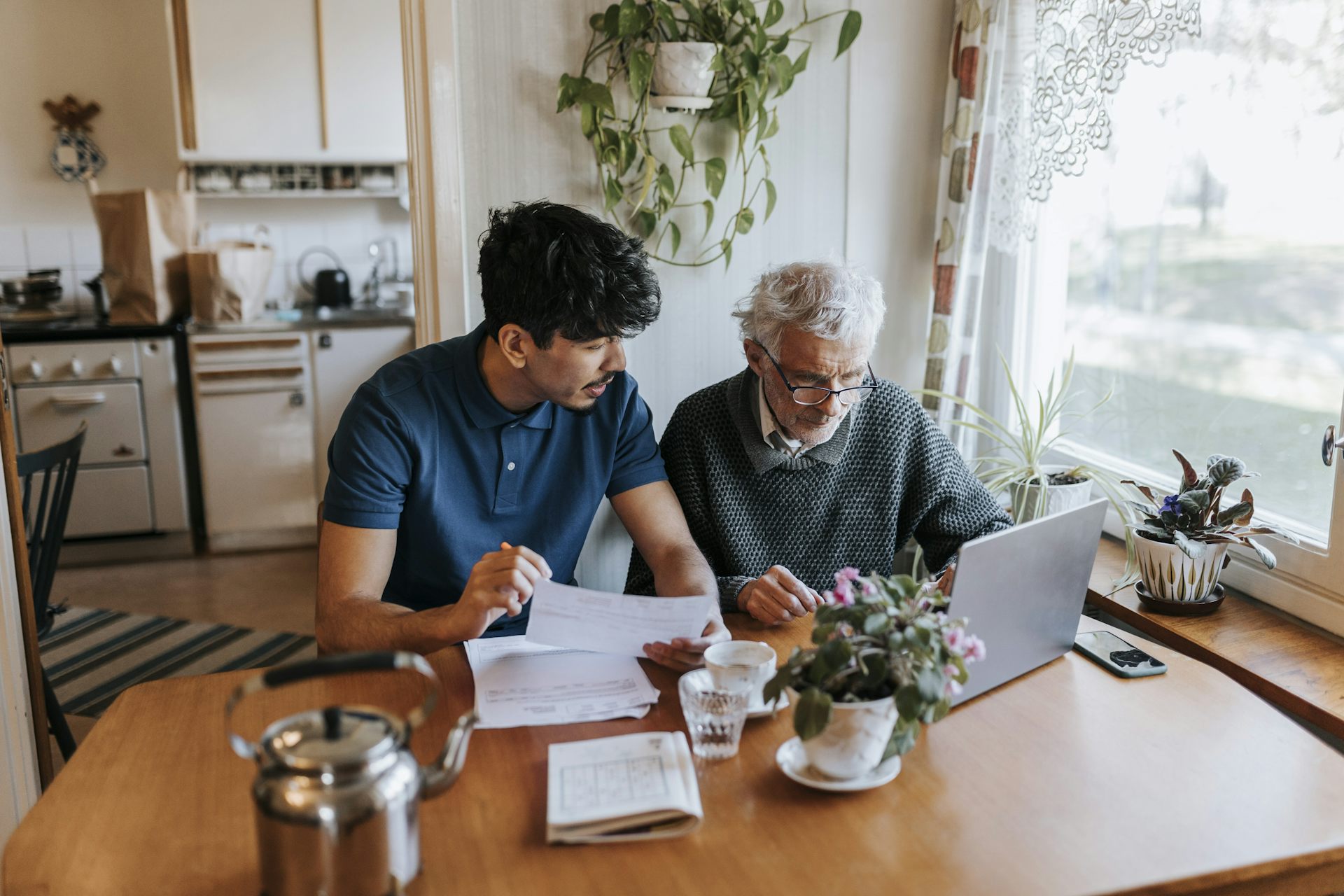We talked to 100 people about their experiences in solitary confinement – this is what we learned
Every day, tens of thousands of American prisoners are locked up in solitary confinement. This is how that looks for those behind bars, and those guarding them.

The United States leads the world in its use of solitary confinement, locking away in isolation more of its population than any other country.
Every day, up to 48,000 inmates – or around 4% of the incarcerated population – are locked in some form of solitary confinement in detention centers, jails and prisons across the U.S.
Some spend months – or even years – at a time in isolation, only being allowed out a few times a week for a 10-minute shower or a short exercise period in an outdoor dog run. And it doesn’t only affect prisoners. Up to 20,000 other people are affected as well – working as correctional staff or providing mental health services or other programming.

Over three summers, we interviewed people who were confined or employed in solitary confinement units to better understand what it is like from both sides of the bars. The interviews form the basis of “Way Down in the Hole,” a book published on Oct. 14, 2022.
In the course of our research, we spent hundreds of hours in solitary confinement units in facilities in a mid-Atlantic Rust Belt state. We conducted in-depth interviews with 75 prisoners and 25 staff members – including both civilian staff and prison officers.
This is what we learned from the interviews. Names have been changed to protect identities.
Solitary confinement is dehumanizing
Everyone we interviewed, both prisoners and officers alike, told us that solitary confinement is like being locked away out of sight, out of mind, and that the consequences on their physical and mental health were significant, and often stripped away their humanity.
Locked in a cell about the size of a mall parking space, prisoners are confined 23 hours a day with virtually no human interaction other than to be subjected to strip searches and have their hands cuffed and their feet shackled. They eat, sleep, meditate, study and exercise just inches away from where they defecate.

One prisoner, an avid reader we will call Scholar, spoke to us nine months into his stay in solitary confinement. “All human privileges are gone; they treat you like a dog. They bring you food, they throw it to you, you shower in a cage, you exercise in a cage. Just because I’m wearing orange [the color of the jumpsuit for incarcerated people confined in solitary] doesn’t mean I’m not human.”
His experience isn’t an isolated one. Marina, who has been confined in solitary for more than a decade, remarked: “I’m treated like I’m in a zoo … I’m being treated like an animal. I feel lost and forgotten.”
Correctional officer Travis, who has worked in solitary confinement for 12 years, expresses a similar sentiment. “You don’t realize how stressful it is inside the walls,” he said. “You feel like an inmate. Inmates are running institutions and you have to do things to take care of them, and no one is taking care of us.”
Solitary confinement breeds racial resentment
Prisons are disproportionately filled with Black and Hispanic people, and solitary confinement is even more intensely racialized.
Black men comprise around 13% of the male population, yet make up nearly 40% of the incarcerated population and 45% of those locked in solitary confinement.
Meanwhile, in many states, including where we conducted our research, most prisons are built in rural communities that are overwhelmingly white. As a result, many corrections staff members – who tend to be drawn from the local population – are white. In hundreds of hours of observation in seven different prisons, we did not see more than a handful of corrections staff who were nonwhite. Yet the majority of people we saw in solitary confinement and whom we interviewed were Black or Hispanic.
In our conversations, guards certainly spoke to the resentment they felt toward prisoners in general and those in solitary in particular.
From their perspective, prisoners have better living conditions than the victims of their crime or the people who staff prisons.
“Inmates get TVs, tablets, kiosks, email; victims get nothing. They don’t get their family member back,” corrections officer Bunker said. “I lived in a bunker in Iraq for a year, and these guys have a better commode … not made of wood that they don’t have to burn.”
Because prisoners in solitary are locked up 23 hours a day, every daily need must be met by an officer. Officers hand deliver and pick up meal trays three times a day. Toilet paper is dispensed twice a week. Prisoners must be escorted to showers and the yard and even to therapy sessions. And before each and every movement out of cell, they must be strip searched, handcuffed and shackled. We watched officers do this for hundreds of hours, and it’s exhausting for the guards. Under these circumstances – and given the relatively low pay guards receive – it is easy to see how resentment builds up.
An officer we call Porter said: “I have an elderly family member who had to give up their house to get a medical procedure, and the inmates get the best medical care for US$5. I knew a guy on death row that got chemo. Imagine that … paying to keep a guy alive just to kill him!”
And, because staff members are almost all white and the prisoners are disproportionately Black, this resentment becomes racialized. Scholar told us the prison he is incarcerated in is “one of the most racist prisons. [The guards] have no problem calling us ‘n*****.’”
And yet, some prisoners choose solitary
Despite the dehumanizing conditions of solitary confinement and the resentment it breeds, we met many prisoners who actively sought out solitary – and staff members who opted to guard those prisoners.
Many corrections staff preferred to work in solitary confinement units for a variety of reasons. Some preferred the pace of the work; some lived for the adrenaline rush of a cell extraction. Others told us that compared to other jobs available in their community, working in solitary was more interesting.
An officer we call Bezos who worked at an Amazon fulfillment center before starting at the prison summed it up: “I could warehouse boxes or warehouse people; people are more interesting.”
Perhaps more surprising, many prisoners also told us they chose solitary.
Some requested solitary confinement for their own safety, to avoid gang violence or the threat of sexual assault by other prisoners or retaliation for debts they owed on the inside or on the outside. Those placed in “administrative custody” – that is, they are placed in solitary not for punishment but for safety – said they experienced fewer restrictions than those who were sent to solitary confinement as punishment.
But many prisoners we interviewed deliberately committed misconducts, such as refusing a guard’s order, as a way of deliberately getting sent to solitary confinement by way of punishment. It was seen by some as a way to control one aspect of their lives.
Others endured the dehumanization of solitary confinement simply to be moved from one housing unit to another or to another prison all together. They did this to be closer to home – which would allow their families more opportunities to visit – or to a prison that had more programming, such as education classes or treatment.
A prisoner we call Fifty committed a misconduct that he knew would get him sentenced to the supermax facility in the state, despite it being known as one of the most racist prisons in the system and one of the hardest places to do time.
The reason, as Fifty explained, was that it kept him isolated from the man who killed his brother. Fifty worried that if tempted, he might kill the man and spend the rest of his life in prison.
The move was successful. Fifty was paroled just a few months after we met him, directly from solitary confinement to the streets of a major U.S. city.
A system in which no one wins
The picture that emerges from the interviews is one of a system that doesn’t serve the prison population or those employed to guard them.
People who spend time in solitary confinement are more likely to die sooner after their release – as are officers, who also have one of the highest rates of divorce. There is also no evidence that confinement acts as a deterrent or is in any way rehabilitative.
Any amount of time in solitary confinement can cause declines in mental health. Many people placed in solitary confinement find they end up back in prison after they are released because they are unable to function or because they haven’t learned tools that help them stay out of trouble.
And, because of the prisoner to staff ratios and individual cells, the cost of holding someone in solitary confinement is around three times that of the general prison population.
From our interviews, the overarching takeaway is it is a system in which no one wins and everyone loses.
The authors do not work for, consult, own shares in or receive funding from any company or organization that would benefit from this article, and have disclosed no relevant affiliations beyond their academic appointment.
Read These Next
Sleep problems and depression can be a vicious cycle, especially during pregnancy − here’s why it’s
Inadequate sleep can have negative downstream effects on everyday cognitive functioning and mental health,…
Donor-advised funds have more money than ever – and direct more of it to politically active charitie
When foundations make grants to DAFs, the digital trail normally created instead becomes a dead end.
How a niche Catholic approach to infertility treatment became a new talking point for MAHA conservat
Mainstream medical organizations have criticized ‘restorative reproductive medicine,’ but some Catholics…






